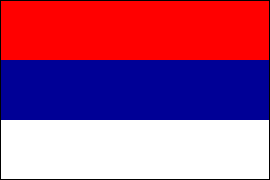
KINGDOM OF SERBIA •
NATIONAL FLAG • 1882-1918 & Since 2004 |
|
KINGDOM OF YUGOSLAVIA |
|
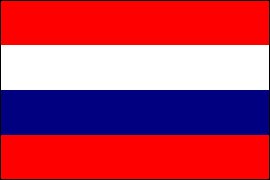
Provisional National Flag • 1918-19 |
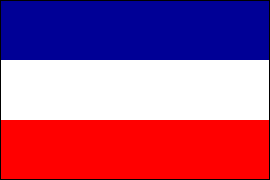
National Flag & Civil Ensign • 1919-41 |
|
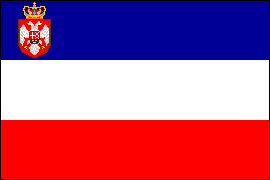
Financial Control Ensign |
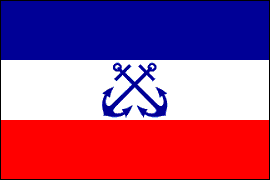
Harbor Police Ensign |
|
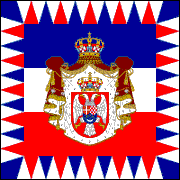
ROYAL STANDARD •
1922-37 |
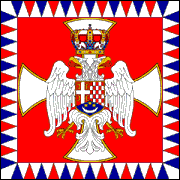
ROYAL STANDARD •
1937-41 |
|
The new Balkan state was officially
titled the Kingdom of Serbs,
Croats and Slovenes. From the start, however, it was informally
called Yugoslavia and this name was made official by royal decree in
1929. Blue, white and red had long been regarded as the Pan-Slav
colors and various unofficial flags of the movement incorporated
them. The ensign hoisted aboard warships of the defunct
Austro-Hungarian Navy that had been taken over by Yugoslavia had
stripes of red, white, blue and red; it may possibly have served
briefly as the national flag. In 1919, however, Yugoslavia adopted a
horizontal blue-white-red tricolor, which was formally confirmed as
the national flag by a law passed in 1922. This law specified a
number of additional flags for the armed forces, government
authorities and high officials. The design of the royal standard was
left to the King's discretion; he chose a design somewhat
reminiscent of the old Habsburg imperial standard, with a border of
triangles and a field in the national colors
with the royal arms. A law of 1937
modified the design of various flags (though the national flag
remained unchanged), including the royal standard. The German/Italian
invasion and subsequent occupation of Yugoslavia resulted in the
suppression of all these flags, though some continued to be used by
the royal government in exile. |
|
SOCIALIST FEDERAL
REPUBLIC OF YUGOSLAVIA |
National Flags |
|
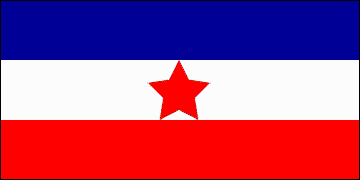
National Flag • 1941-46 |
|
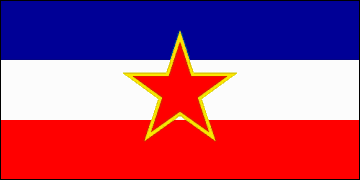
National Flag •
1946-92 |
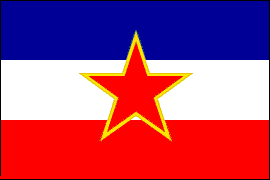
Civil & State Ensign •
1950-92 |
|
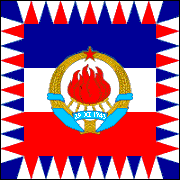
President of the Republic |
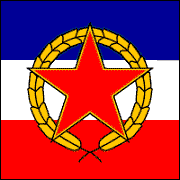
Member of the Presidium •
President of a Constituent Republic |
|
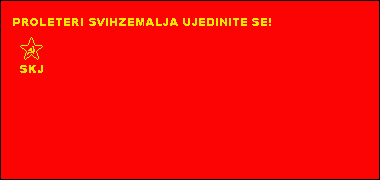
League of Communists
of Yugoslavia
|
|
Flags of the Constituent Republics &
National Minorities |
|
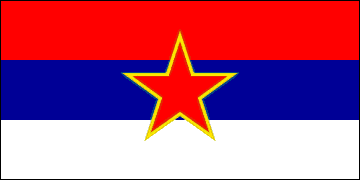
Socialist Republic of Serbia •
Socialist Republic of Montenegro |
|
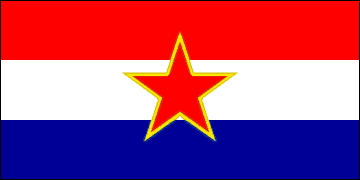
Socialist Republic of Croatia |
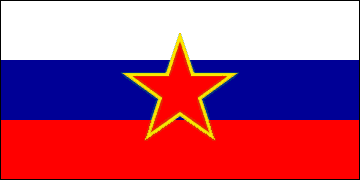
Socialist Republic of Slovenia |
|
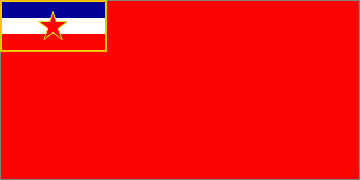
Socialist Republic of Bosnia &
Herzegovina |
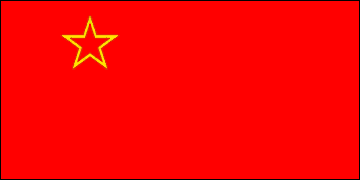
Socialist Republic of Macedonia |
|
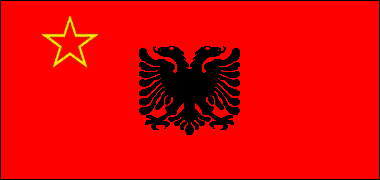
Albanian Minority in Serbia |
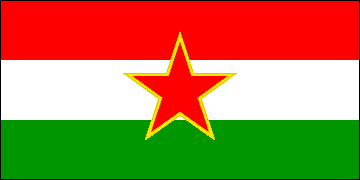
Hungarian Minority in Croatia |
|
The principal resistance to the
German/Italian occupation of Yugoslavia was put up by the Partisan
organization under Josip Broz Tito, a veteran revolutionary of Croat
origin. The Partisans constituted the military arm of the
Communist-dominated Unitary National Liberation Front. After
national liberation the UNLF looked toward the establishment of a
federal republic, communist in ideology, in place of the monarchy.
By 1944 the Partisans had grown into a regular army of
more than 60 divisions and were fighting a conventional war against
the Germans. Thus Yugoslavia was the sole occupied country able to
claim that it had largely liberated itself, albeit with considerable
British contributions of weapons, munitions and other supplies. The
war's end soon saw the establishment of the desired communist state,
with Tito at its head.
During the war the Partisans used
several different versions of the flag first adopted in 1941 when
the movement was formed: the Yugoslavian tricolor with a red
"Partisan Star" on the white stripe. The Partisan Star was also
applied to the flags of Serbia and Croatia. In 1946 Yugoslavia adopted a
new national flag with a larger star, red, bordered yellow, on the
tricolor, this to both commemorate the Partisans and to symbolize
the state's socialist character. For use on land its proportions
were 1:2; a version proportioned 2:3 was adopted as the civil and
state ensign. The presidential flag was the same as the old royal
standard, with the communist style state coat of arms replacing the
royal arms. A square version of the national flag with a golden
yellow wreath added behind the star, was adopted for the used of
high government officials. The ruling party, styled the League of
Communists of Yugoslavia, had a red flag with the motto PROLETARIANS
OF ALL LANDS UNITE! in the upper part over the party emblem and
initials. There were six variants of this flag with the inscriptions
in the various languages of Yugoslavia; that shown above is the
Croat version (Serbo-Croatian language rendered in the Roman
alphabet). Each of the six constituent republics had a flag, and
there were also flags for various national minorities within the
constituent republics. Two of the latter are shown above. |
POST-COMMUNIST
YUGOSLAVIA & THE SUCCESSOR
STATES |
|
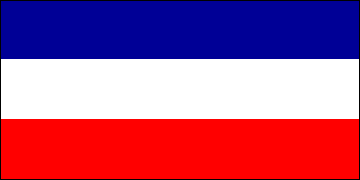
Federal Republic of Yugoslavia
1992-2003 • Serbia & Montenegro 2003-06 |
|
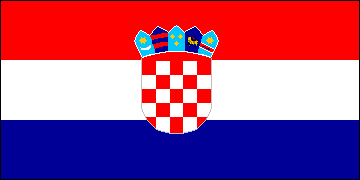
Republic of
Croatia • National Flag Since 1990 |
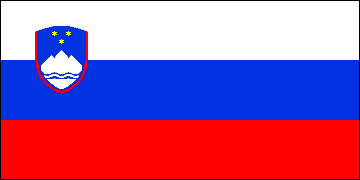
Republic of Slovenia • National Flag Since 1991 |
|
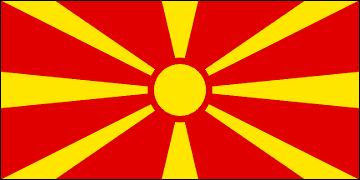
Republic of Macedonia • National Flag Since 1995 |
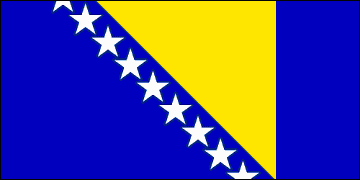
Bosnia and
Herzegovina • National Flag Since 1998 |
|
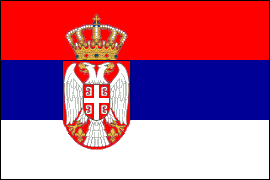
Republic of Serbia
• State Flag Since 2004 |
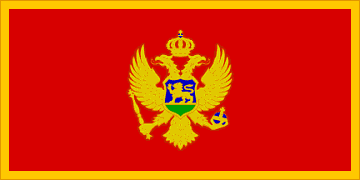
Republic of Montenegro • National Flag Since 2004 |
|
The death of Tito
(1982) removed his strong authoritarian hand from
the direction of Yugoslavian affairs and gradually
the nationalist sentiments of the state's various
peoples began to reassert themselves. Tensions
steadily escalated and by 1990 Yugoslavia had fallen
apart. Some of the constituent republics gained
independence with a minimum of violence, but in
Croatia and Bosnia-Herzegovina there was bloody
fighting. In 1992 only Serbia and Montenegro
remained within the Yugoslavian federation, now
styled the Federal Republic of Yugoslavia. In 2003
the state's name was changed to Serbia and
Montenegro and in 2006, after a plebiscite,
Montenegro broke away from Serbia. Yugoslavia was no
more.
The successor states mostly adopted national
flags based on historical models. The national and
state flags of Serbia, for example, were identical
to that of the pre-Great War kingdom. In Macedonia
and
Bosnia-Herzegovina,
however, the flag question was a contentious one.
Greece, which includes part of historical Macedonia,
objected to that state's first national flag: the
so-called
Sun of Vergina on a red field. The
Greek government claimed that this was a Greek
symbol, associated with Alexander the Great. (Greece
even objected to the new state being called
Macedonia.) Eventually Macedonia agreed to change
its flag, opting for a stylized sun, golden yellow,
on a dark red field. In
Bosnia-Herzegovina the various ethnic groups
squabbled constantly over the choice of a national
flag. The design eventually adopted in 1998 actually
failed to attract majority support in the
legislature, but since it received more votes than
any other proposal the High Representative selected
it. (The Office of the High Representative was a
European agency created to oversee the
implementation of the Dayton Peace Accords, which
brought the civil war in Bosnia-Herzegovina to an
end.) The triangle represents the country's three
major ethnic groups, colored the yellow of the sun
to denote hope for the future. The blue field and
diagonal line of stars symbolize Bosnia's identity
as a European nation.
|


























